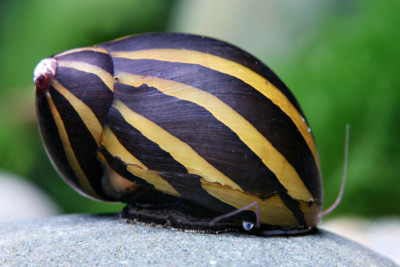Introduction
Neritina pulligera is a little fresh water mollusc.
This sheet is currently being prepared. The texts currently proposed come from our data model or are being drafted. To request priority for this content, you can write to us HERE.
Who is it?
Morphology
-
Type
-
Size2.3 - 3 cm
-
Colourschanging
-
Mimicryplants
-
Type of mouthradula
-
ChromatophoresNo
-
Type
-
Size2.3 - 3 cm
-
Colourschanging
-
Mimicryplants
-
Type of mouthradula
-
ChromatophoresNo
How to recognize This mollusc ?
Neritina pulligera measures between 2.3 and 3 cm. Given its small size, this species is commonly referred to as a "dwarf" animal. This mollusc is unicolore with a predominantly jaune, bleu, vert, noir and marron body.
Behaviour & Life cycle
-
Sociabilityliving in a group or alone
-
Way of livingdiurnal
-
VenomousNo
-
Dietgrazer
Neritina pulligera is a mollusc living in a group or alone naturally found in the vegetation. This species is herbivorous . Measuring only a few centimeters, this small species tends to be discreet and hide in the presence of larger neighbors.
n general, this species does not care much about other animals crossing its path.
Reproduction
-
Reproductionovipare
-
Migratory speciesYes
Neritina pulligera is a mollusc ovipare. This species is amphidromous. It gives birth to larvae in fresh water which are immediately carried by the current of the rivers to the sea. These develop in salt water until a juvenile stage and then migrate from the sea to the interior of the land to continue their growth.
Harmless species
This species does not represent any particular threats to humans when encountered in its natural environment.
Origin and distribution
Conservation status of populations (IUCN)
What is its habitat?
Natural environment characteristics
-
Temperature18 - 30 °C
-
pH (acidity)7 - 8.5
-
FlowMedium
Biotope presentation
Neritina pulligera is most often found at a depth between 0m and 1m. However, it is not impossible to find this species at other depths. This animal evolves in areas characterized by a strong presence of vegetation (aquatic and marsh plants, decaying organic matter, roots...). It is particularly observed near clusters of leaves or plants where it finds food and shelter in case of danger.
This species lives near large roots, in which it can find refuge in case of danger. This type of habitat is often found not far from the banks.
Species of the same biotope
Main recommendations for fishkeeping
Deontology
In order to preserve wildlife, if you acquire this animal, it must not be released into the wild. See also, the Fishipedia charter.
Fishipedia supports the practice of responsible and environmentally friendly aquarium keeping. We encourage maintenance if it is motivated by a desire to understand the biological functioning of living things and if it is done with respect for animal life.
We believe that aquaristics is an opening to the discovery of aquatic environments, especially freshwater, and that this knowledge is necessary to better protect and respect these environments. Logically, we refute the compulsive purchase of animals that would not find a sufficient and / or adapted place in the host aquarium.
Our recommendations
-
Min volume80 liters
-
Population min1
-
Temperature18 - 30 °C
-
pH (acidity)6.8 - 7.2
Characteristics
-
Behaviourpeaceful
-
Robustnesstolerant
Recommended equipment from our partners
-
Aquarium
-
Filtration
General reminders
It is strongly advised to read the complete dedicated file and to get information on the feedbacks of maintenance of the envisaged animal, this to avoid any potential conflict whose end result is generally the death of the individual (or the other inhabitants). It is important not to overload your aquarium to limit pollution. This will make maintenance easier.
In nature, animals are subject to weather conditions and live in waters with variable characteristics. The recommendations offered by our team for aquarium maintenance are a guidance and cannot be assimilated to scientific datas.
General reminder on maintenance datas
Le démarrage d'un aquarium est une partie primordiale pour l'équilibre et le bien-être des poissons. Lorsque l'on met en eau un aquarium, l'eau passe naturellement par un cycle biologique : le cycle de l'azote. Celui-ci dure environ trois semaines. Tous les 2 jours, nous vous conseillons de tester votre eau jusqu'à ce que le taux de nitrite soit à zéro pendant plusieurs jours d'affilée.
Pour accélérer ce cycle, vous pouvez utiliser un activateur de bactéries comme JBL Denitrol. Cette solution riche en bactéries vivantes et enzymes permet une mise en place rapide du cycle de l'azote. Les poissons peuvent alors être introduits plus rapidement.
Il est important de tester l'eau de son aquarium régulièrement pour maintenir un environnement sain pour les poissons et les autres habitants. Les tests d'eau permettent de mesurer les niveaux de différents paramètres tels que le pH, la dureté totale, ainsi que les taux de nitrates, de nitrites et d'ammoniaque.
Pour réaliser ces tests, vous pouvez utiliser des produits d'analyse spécialisés tels que JBL ProScan qui permet de réaliser un diagnostic de l'eau directement via un smartphone. Il existe également des coffrets de tests plus classiques de bandelettes, comme JBL PROAQUATEST.
En cas d’usage de l’eau du robinet, vous pouvez utiliser un conditionneur d’eau de type Biotopol de JBL pour éliminer les substances nocives comme le chlore, le cuivre, le plomb et le zinc. Une eau trop dure ou trop calcaire peut être inadaptée à de nombreuses espèces tropicales d’eau douce. Si nécessaire, vous pouvez la couper avec de l’eau osmosée ou de pluie filtrée afin d’obtenir une dureté plus adaptée aux besoins de vos poissons et de vos plantes. Les conditionneurs d'eau garantissent une meilleure santé aux poissons et une meilleure croissance des plantes.
Chlorine and chloramine are dangerous for the health of animals. Used to disinfect water, these agents are present in significant quantities in tap water. We recommend using an anti-chlorine agent every time you change the water. In addition to chlorine, treatments and medicines sold for aquarium use sometimes contain dangerous heavy metals in high doses.
Specific needs for Neritina pulligera
Neritina pulligera is a species which lives naturally at a temperature between 18 °C and 30 °C. Nitrate levels should remain below 50mg/L. To keep the water clean and unpolluted, plan on changing 20% to 30% of the water volume each month.
The breeding of this species is accessible on condition of being well informed about its needs in aquarium . Any cohabitants must be chosen with care to avoid the loss of animals.
This species is particularly common in the aquarium trade. Animals from long-term breeding are usually acclimatized at a temperature of about 26 °C in neutral water.
Cohabitation & Environment
In a community aquarium context, this species should be kept in a minimum volume of 80 liters.
Neritina pulligera is a peaceful species that generally does not exhibit behavioral problems in a community aquarium.
It should be noticed that this species should not be kept with large crustaceans or fish, as it would become a prey of choice. Smaller species should preferably be inserted in the aquarium some time before the larger ones. Moreover, if you want to breed it, it is better to put them in a specific aquarium.The species enjoys a particularly vegetation-rich environment. The addition of plants will provide many useful hiding places for resting. These areas are also conducive to possible breeding in the aquarium. Floating plants such as Salvinia can be added to recreate the subdued atmosphere characteristic of its living conditions in the wild.
Tips for feeding
Neritina pulligera is herbivorous.
This species can eat dry food (flakes, pellets), fresh food and frozen food. To avoid deficiencies, it is recommended to vary the types of food.
Feed animals in moderation to maintain good water quality. Meals should be eaten within 2–3 minutes, served in several small portions rather than a single large ration.
Uneaten food quickly decomposes, releasing ammonia, nitrites, and nitrates, which disturb the aquarium’s biological balance.
Make sure each species can access food properly, slower or bottom-dwelling individuals may require targeted feeding.Reproduction protocol
-
egg-laying protectionNo
Hybridization risks
In general, it is advised not to mix several species of the same genus or different varieties of the same species, to avoid the risks of hybridization.
These plants might interest you
Plants play a crucial role in aquariums, both for their ability to filter water by absorbing excess nutrients and for their aesthetic contribution. They provide fish with natural hiding places, can serve as breeding sites, and generally help maintain the overall balance and optimal conditions of the aquarium. The selection presented here includes species from the same regions as the species described on this page, although they do not necessarily come from its exact natural biotope.
To go further
Sources & Contributions
Participation & Validation
The Fishipedia team and specialist contributors are committed to providing high-quality content. However, although the information comes from scientific sources or testimonials from specialists, the cards may contain inaccuracies.
Translation
Translation done with the valuable contribution of our translators, who make this information available to a wider audience. We sincerely thank them for their commitment.
Bibliographic references
- - GBIF
- - Revision of the species complex 'Neritina pulligera' (Gastropoda, Cyclonetimorpha: Neritidae) using taxonomy and barcoding - Ahmed Abdou - Clara Lord - Gaël Denys - Philippe Keith - VIE ET MILIEU - LIFE AND ENVIRONMENT - 2017.
- - Taxonomy and Distribution of the Neritidae (Mollusca: Gastropoda) in Singapore - Siong Kiat Tan - Reuben Clements - Zoological Studies - 2008.
- - Molecular evidences confirm the taxonomic separation of two sympatric congeneric species (Mollusca, Gastropoda, Neritidae, Neritina) - Cristiane Xerez Barroso - Helena Matthews-Cascon - Luis Ernesto Arruda Bezerra - Tito Monteiro da Cruz Lotufo - ZooKeys - 2020.
Scientific partners
Tags
Species of the same family
Same genus
Species of the same biotope


























